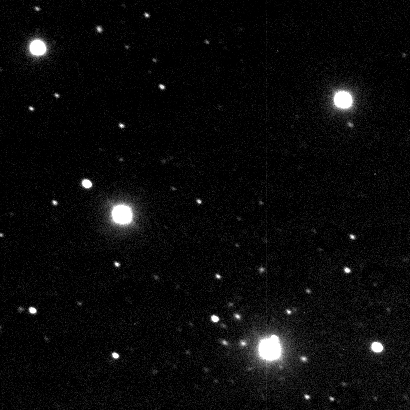
(it's in the center)
Discovered 1997 Mar. 7 by M. W. Buie at the Anderson Mesa Station of the Lowell Observatory.
William O. Hamilton (1933-), Professor of Physics and Astronomy at Louisiana State University, is a pioneer in the development of observational techniques for gravitational radiation. Citation prepared by R. D. Gardner, J. S. Villarrubia, and the discoverer, among the many for whom he created undergraduate research opportunities.
I won't pretend to provide a detailed biography here. For that go to his web site at LSU. Also check out his web site on his gravity wave experiments. I worked for Dr. Hamilton from January 1977 through August 1979 as a laboratory assistant. At the time I was an undergraduate student and physics major at LSU. I learned quite a few skills that have stayed with me my entire career and certainly has much to do with my interest and successes in astronomical instrumentation.
This is the discovery image of the asteroid

(it's in the center)
It's easier to see if you watch the sky in motion. Two animations are available. The first shows a short time-lapse movie with the position of the asteroid held constant (1.8Mb). The second shows the same time-span but this time holding the positions of the stars fixed (1.8Mb) while the asteroid moves in the field. This asteroid has the distinction of being the first one I ever discovered. I was conducting some routine stellar calibration observations when I saw this asteroid drifting through the image. That certainly helped bring some excitement to an otherwise dull night since I needed to learn how to measure the position of the object and project its position forward so I could find in on later nights. This one object got me started into the business of astrometry (measuring positions) and has led to my becoming involved in survey of the Kuiper Belt where I've helped discover thousands of objects in all parts of the solar system.
At the time discovery, it was 2.4 AU from the Sun and 1.5 AU from the Earth. Its apparent visual magnitude was about 18.5. If it is an S-type asteroid (this is just a guess, but they're one of the most common types) a typical albedo would be 18% and implies this object is 2.9 km in diameter.
|
Orbital Element |
Value |
|---|---|
|
Mean anomaly |
105.440306 deg |
|
Argument of perihelion |
224.516766 deg |
|
Longitude of the ascending node |
196.720566 deg |
|
Inclination |
3.964968 deg |
|
Eccentricity |
0.120563 |
|
Semi-major axis |
2.316793 AU |
|
Perihelion distance |
2.04 AU |
|
Aphelion distance |
2.60 AU |
|
Orbital period |
3.526 years |
|
Epoch of osculating elements |
1997/03/07 |
Every 3.5 years or so this asteroid has a favorable close approach to the Eath. Over the next 20 years, it will reach a minimum distance of 1.09 AU when it reaches its peak brightness of V=17.5